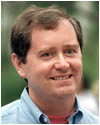
Chris Quigg
 Chris Quigg |
"Within the lifetime of my grandparents, there lived distinguished scientists who did not believe in atoms. Within the lifetime of my children, there lived distinguished scientists who did not believe in quarks. Although we can trace the notion of fundamental constituents of matter-minimal parts-to the ancients, the experimental reality of the atom is a profoundly modern achievement."
For all of human history, people have wondered about the smallest possible pieces of the world around us. The Greek philosopher Democritus (460?-370? BC) named the smallest unit atomus, meaning "not able to be cut." Over time, our ideas of the ultimate building blocks of matter have changed, but never more quickly or profoundly than during the past century.
By the end of the 1800s
-Chris Quigg, theorist, in Beam Line
The stage was set for a drama of discovery: the discovery of the ultimate particles of matter at the smallest scale. In the opening scene, in 1897, British physicist J.J. Thomson, found the first subatomic particle, the electron. In the century to come, discovery after discovery would reveal a new world of particles and forces at the heart of matter.
